Cacti are succulent perennial plants. Cacti generally have thick herbaceous or woody chlorophyll-containing stems. Cacti can be distinguished from other succulent plants by the presence of areoles, small cushionlike structures with trichomes (plant hairs) and, in almost all species, spines or barbed bristles (glochids). Areoles are modified branches, from which flowers, more branches, and leaves (when present) may grow.
In most species, leaves are absent, greatly reduced, or modified as spines, minimizing the amount of surface area from which water can be lost, and the stem has taken over the photosynthetic functions of the plant. The root systems are generally thin, fibrous and shallow, ranging widely to absorb superficial moisture.
Cacti occur in a wide range of shapes and sizes. Although some species live in quite humid environments, most cacti live in habitats subject to at least some drought. Many live in extremely dry environments, even being found in the Atacama Desert, one of the driest places on Earth. Because of this, cacti show many adaptations to conserve water.
Cactus is a member of the plant family Cactaceae, a family comprising about 127 genera. The six cactus genera with the largest number of species, and hence most likely to be encountered, are cereus, cylindropuntia, echinocereus, ferocactus, Mammillaria and optuntia. Less common genera include ariocarpus, coryphantha, echinocactus, echinomastus, epithelantha, escobaria, glandulicactus, grusonia, pediocactus, sclerocactus and thelocactus.
List of indoor cactus
- Christmas cactus (Schlumbergera)
- Fairy castle cactus (Acanthocereus Tetragonus)
- Star cactus (Astrophytum asterias)
- Barrel cactus
- Old lady cactus (Mammillaria hahniana)
- Moon cactus (Gymnocalycium mihanovichii)
- Lady Finger cactus (Mammillaria elongata)
- African milk tree cactus (Euphorbia trigona)
- Parodia
- Bunny ear cactus (Opuntia microdasys)
- Feather cactus (Mammillaria plumosa)
- Blue columnar cactus (Pilosocereus Pachycladus)
- Easter cactus (Schlumbergera gaertneri)
- Bishop’s cap cactus (Astrophytum myriostigma)
- Powder puff cactus (Mammillaria bocasana)
- Balloon cactus (Notocactus magnificus)
- Monkey Tail Cactus (Cleistocactus colademononis)
- Starfish Cactus (Stapelia gettleffii)
- Zigzag Cactus (Epiphyllum anguliger)
- Chin Cactus (Gymnocalycium)
List of outdoor cactus
- Arizona barrel cactus (Ferocactus wislizeni, the fishhook barrel cactus)
- Queen of the night cactus (Epiphyllum oxypetalum)
- Strawberry cactus (Mammillaria dioica, California fishhook cactus)
- Saguaro cactus (Carnegiea gigantea)
- Prickly Pear cactus (Opuntia)
- The old man cactus (Cephalocereus senilis)
- Golden barrel cactus (Echinocactus grusonii)
- Monk’s hood cactus (Astrophytum ornatum)
List of cold-hardy cactus
- Hedgehog cactus (Echinocereus engelmannii)
- Club cholla (Grusonia clavata)
- Beehive cactus (escobaria vivipara)
- Horse crippler cactus (Echinocactus texensis)
Types of indoor cactus
Christmas cactus

Most species of Schlumbergera have stems which resemble leaf-like pads joined one to the other and flowers which appear from areoles at the joints and tips of the stems. The flowers either hang downwards and are almost regular (radially symmetrical or actinomorphic) or, as in most species, are held more or less horizontally with the higher side of the flower different from the lower side.
Fairy Castle Cactus
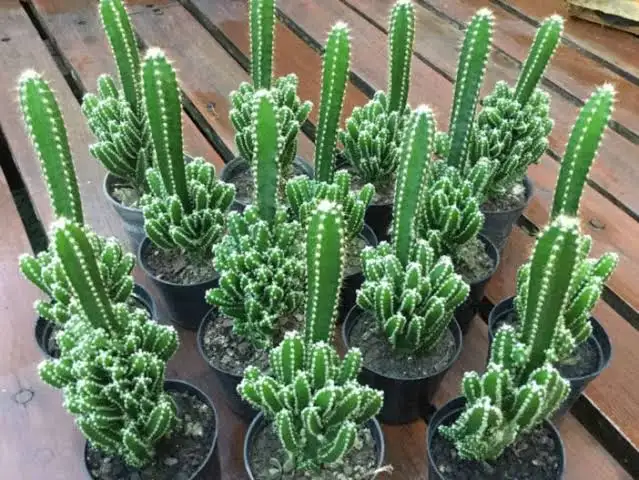
This columnar cactus got its name because the multiple clumping stems grow up in a formation reminiscent of the turrets of a medieval castle. Each stem of the fairy castle cactus is a five-sided fleshy branch with wooly spines on each ridge. It is generally bright green, but variegated types are also available. This cactus rarely blooms but when it does, it produces large, white flowers.
Also Read: Different Types of Flowering Cactus
Star cactus
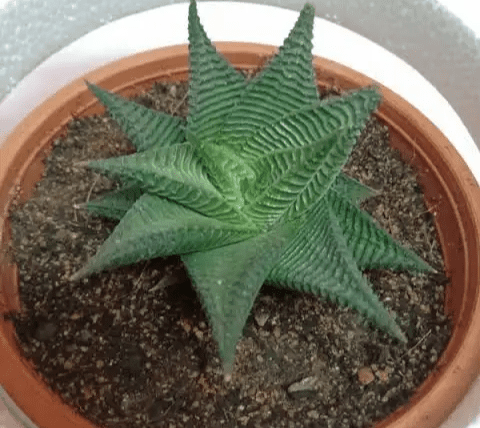
Star cactus also known as sand dollar cactus, sea-urchin cactus or star peyote is a flat, or at most, dome-shaped, spineless cactus to 15 cm in diameter. The green or dark-green to brownish green stems are divided into eight triangular sections. Each section has a row of small, white tufts of hairs down its middle. Generally, the stems are also dotted with scattered white specks. Star cactus flowers are yellow with a red to orange center. The green, woolly fruits are oval and turn brown-red at maturity.
Old lady cactus
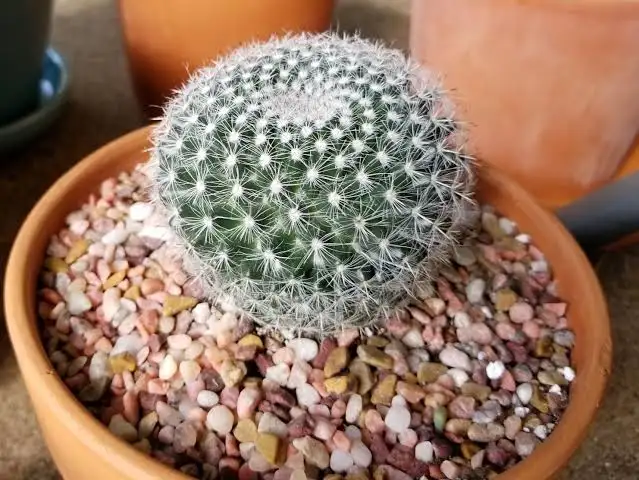
The Mammillaria Hahniana features stunning spherical stems that are covered in sharp white spines and white down. These spheres grow to be around 4 inches tall, and 5 inches wide, though over several years this can evolve to a height of up to 10 inches. This is one cactus that does not like being lonely, and often grows in groups, creating a collection of spheres.
Barrel cactus
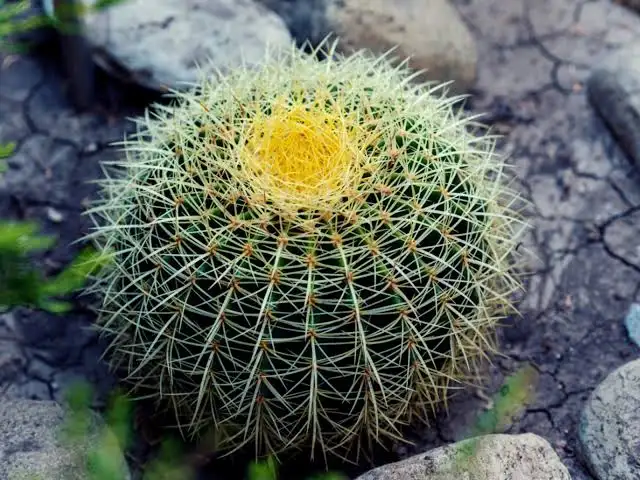
Barrel cactus plants are characterized by their ribbed, cylindrical shape. The cacti come in many sizes and may be low and squat or as tall as 6 feet in height. The ribs are numerous and pronounced, and the spines are long and can range in color from yellow to tan to red, depending on the age of the plant and the species. Flowers appear at the top of the plant only after many years. The barrel cactus can live to be over 100 years old. Barrel cactus buds typically start to bloom in April with a bright yellow or orange flower. Pink and red varieties also exist but occur less frequently. The flowers only appear on the very top of the plant.
Ladyfinger cactus
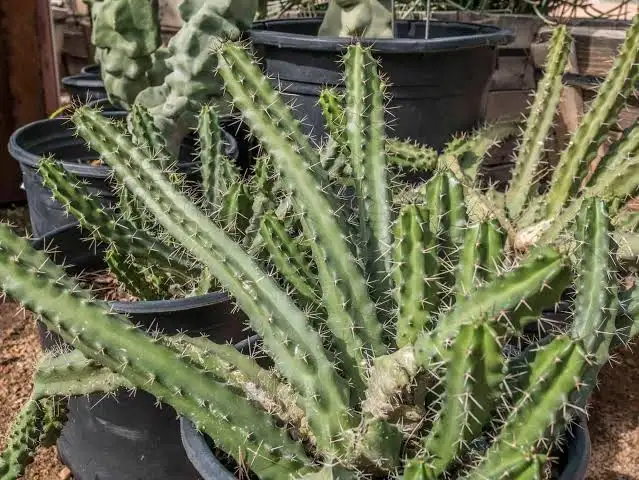
The gold lace cactus also referred to as ladyfinger cactus, forms dense groups of cylindrical, erect or semi-prostrate stems about 6 to 15 cm long. Its body, bright green, is formed by short conical tubercles ending in round and woolly areoles in the young segments, unlike tubercular axils that lack wooliness. It has between 15 and 30 short radial spines, curved outwards that intersect with those of the nearby areoles and 1 to 3 central (sometimes absent) yellow or golden color. The flowers arise on the upper part of the stems, with pale yellow or white toothed petals, sometimes with a darker or reddish central. It is among the most common and most variable of its genus in nature, and is a popular subject for cultivation.
Moon Cactus

Also known by the common names ruby ball cactus, star flowered cactus, and red cap. Moon cactus plants come in vibrant bright colors of hot pink, brilliant orange, and even an almost neon yellow. They are commonly sold as gift plants and make lovely window box or southern exposure houseplants. At maturity, the moon cactus have a broad-spherical, gray-green, often reddish body and is approximately one to two inches wide and has clusters of small, sharp spines.
Also Read: Different Types of Aloe Vera Plants
African milk tree cactus
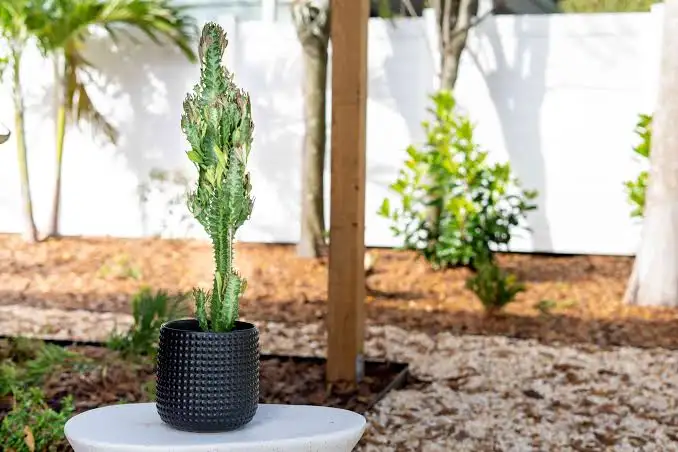
Also commonly known as a good luck plant, likely because of how quickly it grows. As a houseplant, the African milk tree typically grows between 2 to 4 feet tall. If left to grow outside, however, this hearty plant can reach up to 8 feet high. The stem of the African milk tree is typically a dark green color and it’s covered in small thorns about 5 millimeters long. The thorns grow in pairs and a single leaf grows between them. This plant is very popular because it stays lush and green throughout its whole growing season and new growth comes in as a pretty, light green color.
Parodia

These plants produce clusters of rounded, ribbed and spiny stems and funnel-shaped flowers, opening from often woolly buds at the apex. Native to upland regions of South America they vary from small, ground-hugging plants to 1m high columnar species. In cultivation they are usually grown under glass.
Bunny ear cactus
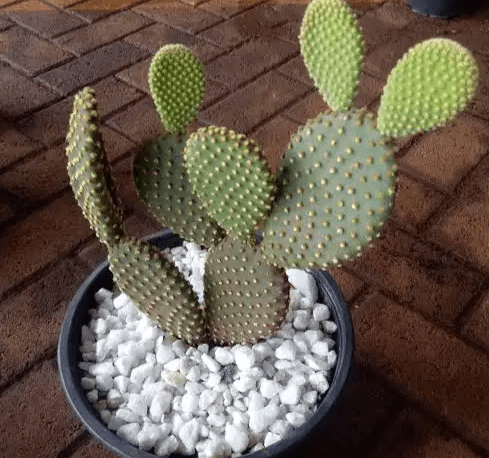
Opuntia microdasys is known by several common names including bunny ear cactus, angel’s wings cactus, and polka dot cactus. Instead of spines it has numerous white or yellow glochids 2–3 mm long in dense clusters. They are barbed and thinner than the finest human hairs, detaching in large numbers upon the slightest touch. If not removed they will cause considerable skin irritation so the plants must be treated with caution. They are an excellent choice for growing outdoors in desert gardens, rock gardens, xeriscape gardens, or Mediterranean gardens. Also, many growers prefer to keep their Bunny cacti indoors planted in a lovely container.
Feather Cactus
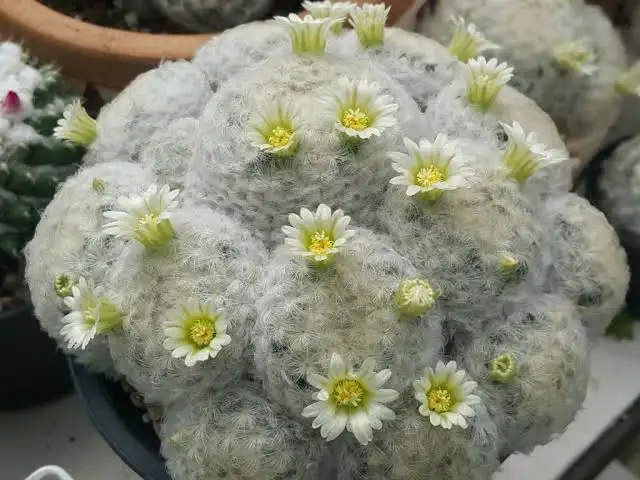
With a rounded, compact growth form, what lends Mammillaria plumosa ‘Feather Cactus’ its name is the wispy texture of the hair-like spines emerging from its tightly spaced tubercles. All together, these ‘feathers’ nearly obscure the dark green base coloration of the plant, lending it a delicate aesthetic made all the more appealing by the dainty, butter yellow blooms that will emerge during the springtime. Establishing clusters that can reach up to 5 inches tall and over 16 inches wide, thanks to a readily offsetting growth habit, ‘Feather Cactus’ will perform the best when provided with ample bright, or even direct, sunlight each day.
Also Read: Different Types of Succulents For Your Home Garden
Blue column cactus

Pilosocereus pachycladus (also known as the blue column cactus) has a branched form and grows fairly quickly, often adding between 1 and 2 feet of height a year. Those that flower do so at night and all are most easily identifiable by their attractive blue-green skin, which is complemented by bright yellow spines. Pilosocereus cacti are mostly tree-like, and their flowers are shaped like tubes and grow fleshy fruits. In cultivation, they are planted and grown year-round, mostly in greenhouses due to their large size and need for warmth in the winter.
Easter cactus
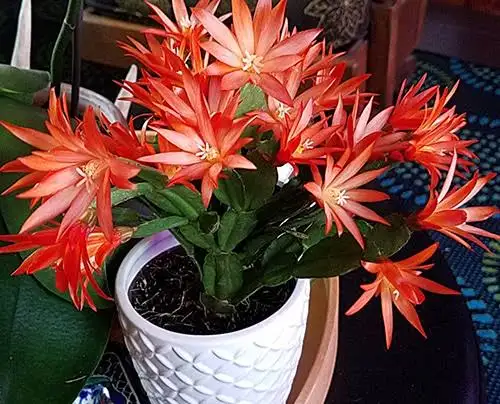
The Easter cactus forms from a single, squat stem. From this, elongated leaf segments grow. Unlike other holiday cacti, the Easter variety has no scallops or teeth on a healthy leaf. These leaves darken in color as they age, beginning life as pale green. They will grow wider and flatter with age, with fully grown segments measuring 1.5-3 inches, and up to 1 inch wide. When fully grown, segments will arc toward the ground under their own weight. In late April and early May, this cactus will form stunning starburst shaped flowers in crimson hues.
Bishop’s cap cactus
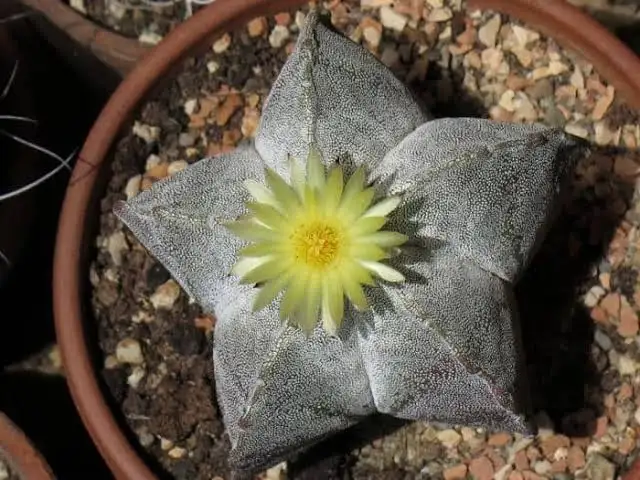
Astrophytum myriostigma, the bishop’s cap cactus, bishop’s hat or bishop’s miter cactus, usually reaches no more than 100 cm (39 inches) in height and up to 20 cm (8 inches) in diameter. It has four or five distinct ribs that increase to eight or more with age. The plant is globose when young, becoming cylindroid as it gains more ribs. The gray-green flesh is covered with white flecks. The fragrant yellow flowers have numerous petals and usually appear in early spring or summer during the day.
Powder puff Cactus
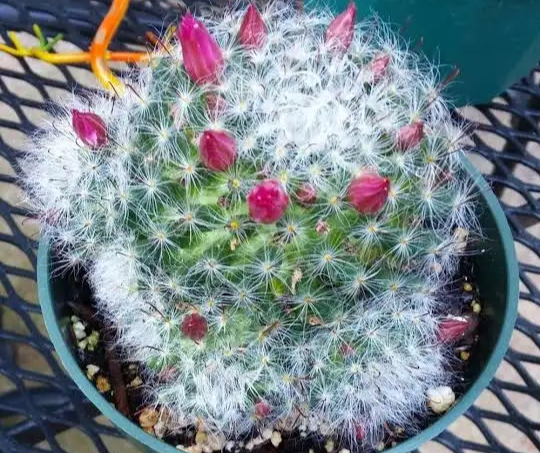
Mammillaria bocasana is a species of cactus is often sold as a “powder puff” cactus, and also as a “Powder Puff Pincushion.” The powder puff cactus grows rapids, producing small, round offsets that cluster around the parent plant. The body of the cactus itself is stocky and usually a blue/green color, covered in white, silky hairs that encase the entire plant. It may look fluffy, but take care not to touch it—the spines are pretty sharp. It will produce small white or red flowers in summer, often in a circular or halo shape.
Balloon cactus
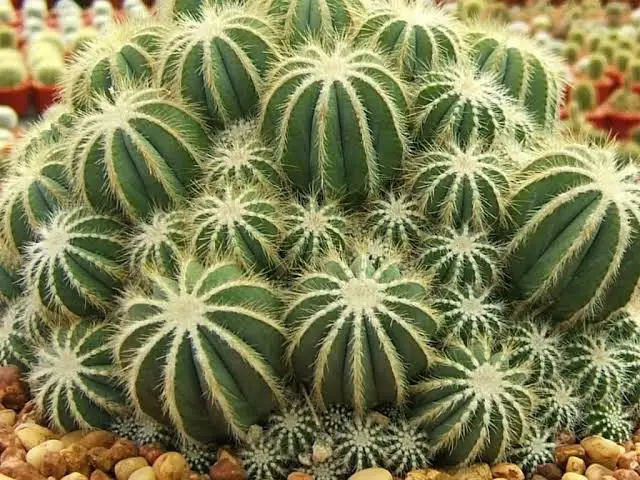
Balloon cactus is also known as Notocactus Magnificus or Parodia Magnifica is a gorgeous, bluish-green globular cactus that has a regular pattern and grows in a cluster. Their round appearance is to credit for their shapely name, and they can grow in pots in clusters up to over a foot wide. Ball cacti are moderate growers, adding about 4 inches to their height each year. Older plants will frequently produce flowers in beautiful shades of yellow, red, orange, or pink, and all varietals feature ridges of spikes that start white and grow to a yellow-brown with age.
Also Read: Different Types of Haworthia Succulents For Your Home Garden
Monkey Tail cactus
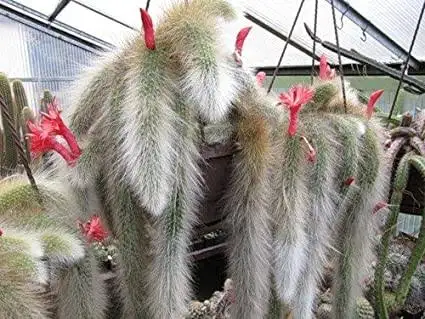
The Monkey Tail Cactus derives its name from its long supple stems that are covered in soft spines that look like strands of white hair(droopy). Except for their light green color, the stems look and feel like primate’s appendages. A single plant can have three to five stems, which branch at the bottom. The plant grows upright for a few feet then the stems become pendant and droop. They produce bright, red flowers that are particularly very decorative. They bloom for a few days then turn to fruits with a brief life span. The Monkey Tail is classified as a Lithophyte, as it has shallow roots and grows naturally among stones and in the crevices of cliffs, surviving off the moisture in the atmosphere.
Starfish cactus
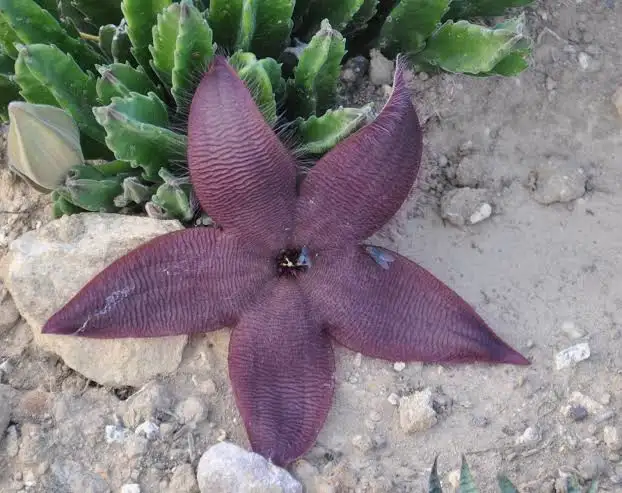
The starfish cactus (Orbea variegata), also referred to as a carrion flower, like most succulent plants, they are low-growing, green, and fleshy. They grow upright from the soil in dense clumps. Their four-angled stems are leafless with blunt ‘teeth’ running along its length.These plants bloom in fall. Compared to their stems, the solitary flowers are very showy with sizes ranging from 1-inch to 12-inches in diameter (2). The flowers themselves are hairy, and star shaped. They vary in color from pale yellow with intricate red patterns to almost completely crimson. Although the starfish moniker refers to the plant’s pleasant, star-shaped flowers, its other nickname — carrion flower — refers to the rotten smell it gives off.
Zigzag Cactus

Fishbone cactus boasts many colorful names. Ric Rac, Zigzag and Fishbone orchid cactus are just a few of these descriptive monikers. The names refer to the alternate pattern of the leaves along a central spine that resembles a fish skeleton. This stunning plant is an epiphytic specimen that can grow in low soil situations where other organic media are present. Growing fishbone cactus is easy even for the so-called “black thumb” gardener. Bring in a fishbone cactus houseplant and enjoy the crazy zigzag pattern of its succulent foliage.
Chin cactus

Gymnocalycium Baldianum (dwarf chin cactus) is a small cactus, bulb-shaped body, semi flattened measuring 3 to 4” inches tall. The small plants are globose to cylindrical and are so named for the chinlike protuberance below each spine-bearing areole (special bud) on the ribs. The showy diurnal flowers are most often white or cream, with shades of pink, yellow, or red in some species and varieties. The receptacle (the flower stalk upon which the flower organs attach) characteristically lacks spines or hairs.
Types of outdoor cactus
Arizona barrel cactus
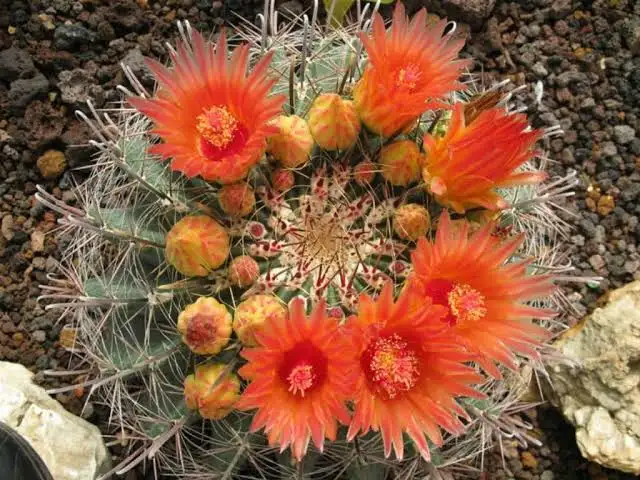
Ferocactus wislizeni, the fishhook barrel cactus, also called Arizona barrel cactus, candy barrel cactus, and Southwestern barrel cactus, forms a tall cylinder up to ten feet high, though four to six feet is more common, often leading towards the southwest. Some aged plants may topple completely and grow sideways, if their roots remain intact, but otherwise falling over is one of the most common ways for the cactus to die.
The 20 to 30 straight ribs bear clusters of generally dull colored spines – white, gray or brown, with a long (up to 5 inches), strongly hooked central spine, 1 to 3 smaller ones, and 6 to 16 radials which are white, thin and bristle-like. The relatively light spination – adjacent clusters do not generally overlap – allows the green stems to be clearly visible, unlike the similar ferocactus cylindraceus which has a much denser, overlapping lattice.
Queen of the night cactus
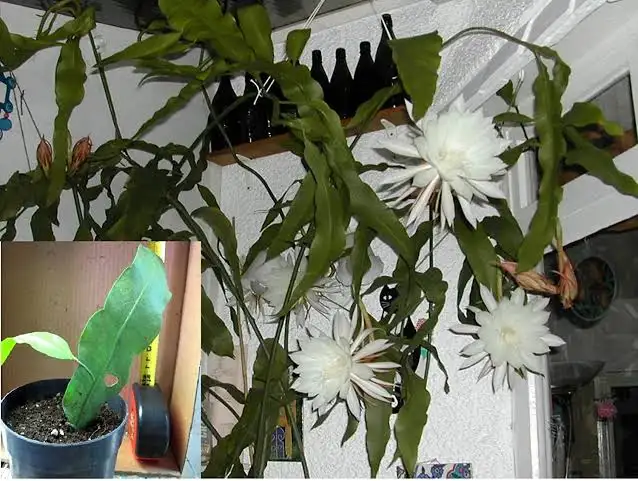
Epiphyllum oxypetalum, the Dutchman’s pipe cactus, princess of the night or queen of the night and also known as the orchid cactus, is one of the most commonly cultivated species of the genus Epiphyllum. This species boasts large, fragrant white flowers that open only at night, as its common name suggests. The stems have 6-8 prominent ribs, and areoles with groups of long (1-5 cm), yellow, brown or black spines are situated on the ridges.
The fragrant, nocturnal flowers are large and funnel-shaped, the inner floral parts being white and the outer ones greenish, sometimes tinged crimson or brownish. The floral tube is smooth and spineless. The flowers give rise to large (4 cm or more across), egg-shaped, crimson to pinkish red (seldom yellow or orange) fruit that split open along 1-3 slits to reveal white pulp dotted with small, black seeds. The delicious fruit attract birds, which are the most important means of dispersal for the seeds.
Also Read: Major Types of Euphorbia Plants For Indoor And Outdoor Spaces
Strawberry hedgehog cactus
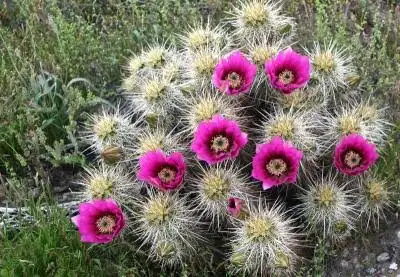
Echinocereus stramineus (Strawberry Hedgehog Cactus) is a small clumping cactus forming large colonies of as many as 100 or more stems at maturity. The stems are composed of 10 to 13 ribs with fairly deep furrows between them. Very large and beautiful, bright pink to purple-red flowers 12 cm decorate the plant in summer. They give way to edible, strawberry-tasting fruits, that are devoured by wildlife. Echinocereus stramineus is a lovely plant for a rock garden or containers where it will form attractive, bold clumps.
Saguaro cactus

The saguaro cactus (Carnegiea gigantea) is one of the defining plants of the Sonoran Desert. These plants are large, tree-like columnar cacti that develop branches (or arms) as they age, although some never grow arms. These arms generally bend upward and can number over 25. Saguaros are covered with protective spines, white flowers in the late spring, and red fruit in summer.
The saguaro has a surprisingly shallow root system, considering its great height and weight. It is supported by a tap root that is only a pad about three feet long, as well as numerous stout roots no deeper than a foot, emanating radially from its base. More smaller roots run radially to a distance equal to the height of the saguaro. These roots wrap about rocks providing anchorage from winds across the rocky bajadas.
Prickly pears cactus
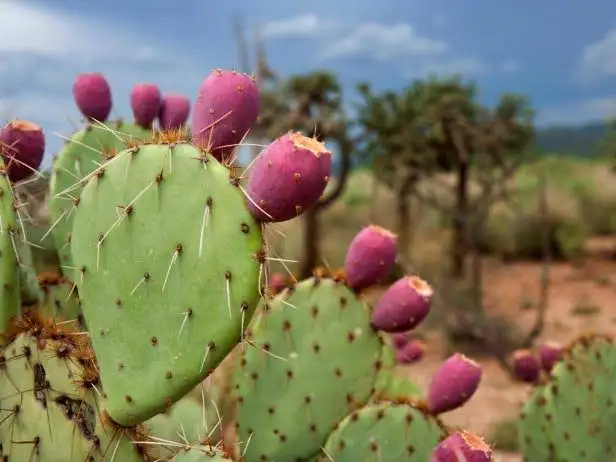
Prickly pears are a subgroup of Opuntia, identified by their wide, flat, branching pads, and are often called nopal cactus or paddle cactus. It is bushy to treelike, growing to a height of over 3.5 metres. It bears large yellow flowers, 3 to 4 inches across, followed by white, yellow, or reddish purple fruits. It is widely grown in warmer areas for the fruit and edible paddles and as a forage crop. The hard seeds are used to produce an oil. Because of their high water content, the stems, especially of spineless varieties, are used as emergency stock feed during drought.
The old man cactus

The old man cactus is a tall, columnar species with clusters of stems that may grow to 5–15 m tall; the individual stems are usually unbranched, being unable to withstand the weight of side branches adequately. The most striking feature is the shaggy coat of long, white hairs suggestive of unkempt hair on an old man. The coat is a particularly striking silvery white on the young cactus; as the plant ages the stem begins to lose its covering. The flowers are red, yellow, or white, though the plant may not flower until 10–20 years old.
Also Read: Poisonous Aloe Vera Plants You Need To Know
Golden Barrel cactus
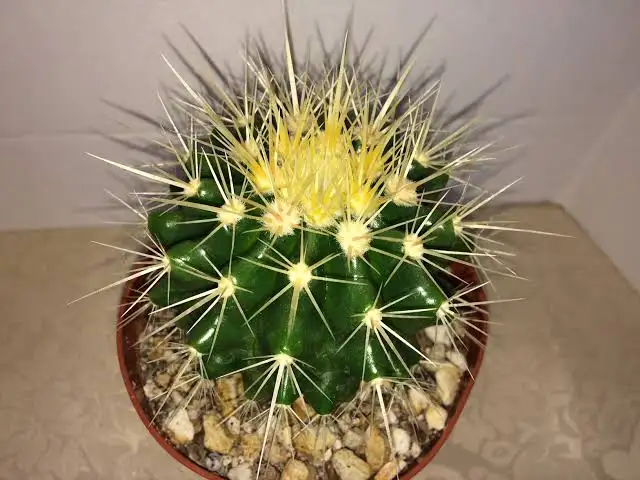
Golden Barrel Cactus (Echinocactus grusonii) is an eye catching feature plant for a drought tolerant garden. The globular shaped stem can grow up to 60 inches tall and 36 inches wide in the wild, or where they are given conditions similar to the natural Mexican habitat. This stem is ribbed and produces prickly yellowish spines (there is also a spineless type), and the crown of the cactus has white colored woollen hairs at the top. The golden barrel cacti will produce yellow flowers during mid-summer, although these are unlikely to appear indoors. The barrel cactus is primarily suited for growing in garden rockery settings, desert type landscapes, patios and botanical gardens.
Cold-hardy Cactus
Hedgehog cactus

This cactus earned its name because its short, spiny stems resemble hedgehogs. It is also called Engelmann’s hedgehog cactus, named for the botanist and physician George Engelmann. Hedgehog cactus is common in its native range and produces colorful flowers in the spring. This cactus grows in clumps of three to 60 stems per clump. Each light green stem grows up to 12 inches tall. As more and more stems grow, the clump can spread to 3 feet wide. The stems are cylindrical bodies with 11 to 14 ribs. Areoles – specialized areas on cacti from which spines grow – develop along the ribs. Each areole produces eight to 20 sharp spines up to 3 inches long. Hedgehog cacti often develop an almost solid covering of these sharp spines.
Beehive cactus
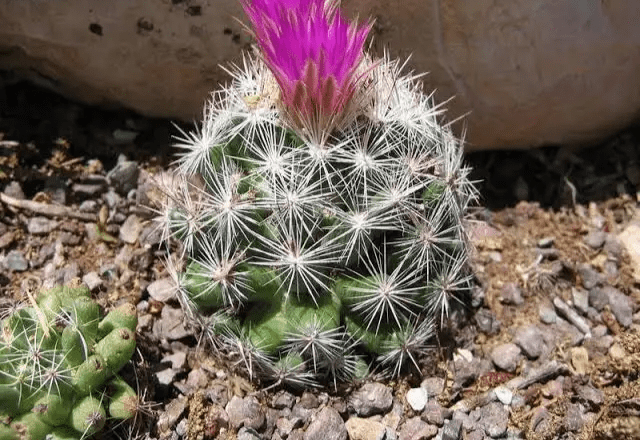
Coryphantha, or beehive cactus, is a genus of small to middle-sized, globose or columnar cacti. Beehive cacti flowers are large for the size of the plant; they are in shades of lavender, rose purple, pink, orange, yellow, and white. Fruits of the genus are green, red, or yellowish edible berries, and the seeds have a characteristic reticulate (netlike) pattern.
Also Read: Different Types of Echeveria Plants For Indoor And Outdoor Growing
Club chollas

Club chollas typically are very spiny, mat-forming species that stay close to the ground. They usually branch from the base of the plant, but in this example the branches form at the tips. As a group, the club chollas have no sheaths on their spines.
Horse crippler cactus
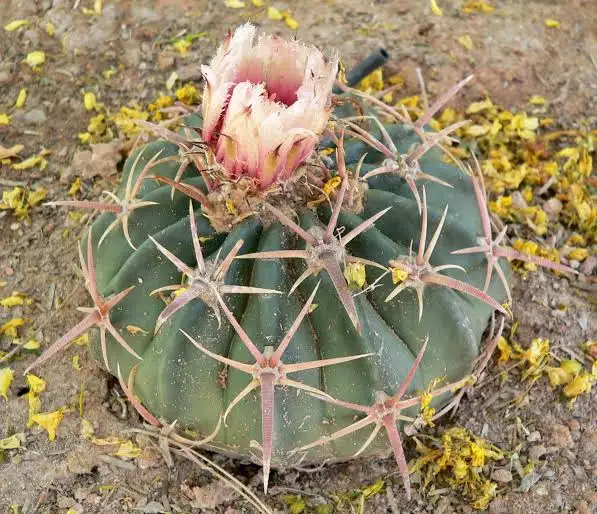
Echinocactus texensis is known as the horse crippler cactus since its rigid, flattened stems with their strong spines. The cactus is usually (at least) twice as wide as it is high, and may reach a diameter of 12 inches. Ribs are wide and prominent, bearing clusters of spines at intervals of 1 to 2 inches. All spines have narrow lateral grooves; the 5 to 7 radials are shorter, but still thick and sharp, while the single, downwards-pointing central spine is longer, up to 3 inches. Both the salmon pink flowers and bright red fruits are quite striking, and the plant is popular amongst cacti collectors, partly due to its resilience, being both frost-hardy and tolerant of increased watering.